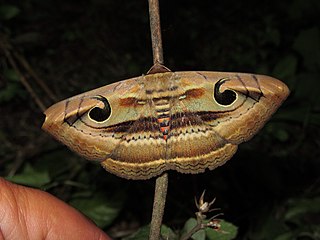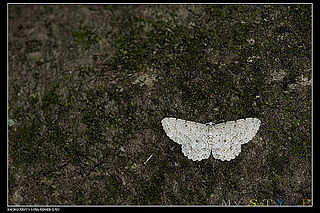
Erebus macrops, the common owl-moth, is a species of moth of the family Erebidae first described by Carl Linnaeus in 1768. It is found in the subtropical regions of Africa and Asia. The wingspan is about 12 cm, making it exceptionally large for an Erebidae species. The larvae feed on Acacia and Entada species.

Hulodes caranea is a species of moth of the family Erebidae first described by Pieter Cramer in 1780. It is found from India, Sri Lanka, Myanmar, Java, Hong Kong to Queensland and New Guinea, it is also found on the Marianas and Carolines.

Eudocima homaena is a moth of the family Erebidae first described by Jacob Hübner in 1816. It is found in the Indian subregion, Sri Lanka, Myanmar, Taiwan, the Nicobars, Peninsular Malaysia, Borneo, the Philippines and on Christmas Island. It is a major pest on orange plants.

Ctenoplusia limbirena, the Scar Bank gem, or silver U-tail, is a moth of the family Noctuidae. It is found in south-western Europe, Africa, the Canary Islands, Arabia, the southern Himalayas, India, Sri Lanka, Indochina to south-eastern China, Taiwan, Sulawesi, Bali and Timor. In New Zealand, it has been established since 2011.

Mnesiloba dentifascia is a moth of the family Geometridae first described by George Hampson in 1891. It is known from the Oriental tropics.

Gesonia obeditalis is a species of moth of the family Noctuidae first described by Francis Walker in 1859. It is found from eastern Africa, the Seychelles, the Maldives and the Oriental tropics of India, Myanmar, Sri Lanka east to the Philippines, the Sula Islands and Australia. The adult moth has brown wings with a scalloped dark brown band near the margin. The hindwings are similar in pattern to the forewings but are a paler shade of brown.

Spirama retorta, the Indian owlet-moth, is a moth of the family Erebidae. The species was first described by Carl Alexander Clerck in 1764. It is found in China, Korea, Japan (Honshu), India, Nepal, Bangladesh, Thailand, Cambodia, Myanmar, Vietnam, Taiwan, Sri Lanka, Malaysia, the Philippines (Luzon), Indonesia ,Japan.

Scopula fibulata is a moth of the family Geometridae first described by Achille Guenée in 1858. It is found in Kenya, Sri Lanka and China.
Scopula pedilata is a moth of the family Geometridae. It is found in Sri Lanka.
Gymnoscelis deleta is a moth in the family Geometridae. It is found in India, Korea, Japan, Taiwan and probably in Sri Lanka according to Hampson.
Anydrelia distorta is a moth in the family Geometridae first described by George Hampson in 1895. It is found in India, Nepal and China.
Racotis boarmiaria is a species of moth of the family Geometridae described by Achille Guenée in 1857. It is found in India, Sri Lanka, Maldives, Myanmar, China, Japan, Taiwan, Indonesia, Bhutan and Malaysia.
Epiplema albida is a species of moth of the family Uraniidae. It was described by George Hampson in 1895. It is found in India, and Sri Lanka.
Ambia chalcichroalis is a moth in the family Crambidae. It was described by George Hampson in 1906. It is found in South Africa.

Catoria sublavaria is a moth of the family Geometridae described by Achille Guenée in 1857. It is found in the tropics of India, Sri Lanka, Myanmar, towards New Guinea, to the Bismarck Islands and Taiwan.
Conchylodes concinnalis is a moth in the family Crambidae. It is found in Mexico and the south-eastern United States north to Ohio. In the west, the range extends to Arizona and southern California.
Sufetula nigrescens is a moth in the family Crambidae. It was described by George Hampson in 1912. It is found in the Democratic Republic of the Congo, Ivory Coast, Madagascar, Nigeria and Sierra Leone.
Sufetula polystrialis is a moth in the family Crambidae. It was described by George Hampson in 1912. It is found on the Louisiade Islands.
Syllepte methyalinalis is a moth in the family Crambidae. It was described by George Hampson in 1912. It is found in Guyana.
Microblepsis cupreogrisea is a moth in the family Drepanidae. It was described by George Hampson in 1895. It is found in Myanmar, the north-eastern Himalayas and on Borneo and Sumatra.








